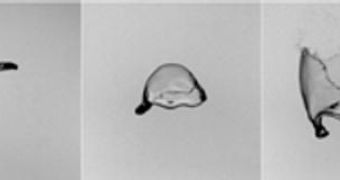Everyone who has been outside while it was raining knows that the droplets falling to the ground are not of the same size. In fact, the differences between them are quite remarkable. And, while this is pleasing to experience first-hand, it has left physicists completely in the dark. Some theories trying to explain this phenomenon exist, but a new high-definition video, captured with cameras able to record up to 1,000 frames per second, shows an interesting “parachute effect.” This breaks individual droplets into many smaller ones, of various sizes.
The experiments were carried out while the droplet was falling through an ascending air stream. The air drag forced it to compact into the shape of a pancake, and then in that of a balloon, with the open end facing downwards. Eventually, as the drop neared the ground, and the air drag increased, instabilities at the molecular level broke off the rim of the balloon, and “exploded” the droplet into what looked like an exploding parachute. The end result was that the droplet spread smaller drops of various sizes all around it in mid-air, which might account for the variations in size we see in rain.
Physicists are happy with the new evidence because it saves them the trouble of having to perform extremely complex equations to account for differences in droplet sizes. In a previous explanation, experts argued that the drops collided and coalesced with each other in mid-flight, and that they broke apart because heavier and larger ones slammed into each other. However, it required very complex mathematical models to account for such interactions, which occur chaotically.
“I was expecting things to get complicated, with lots of empirical relationships thrown together. Instead, based on a few physical ideas, the authors manage to explain a beautiful empirical relationship (...) in a simple and universal way,” University of Bristol water drop dynamics expert, Physicist Jens Eggers tells ScienceNow in an interview.
Emmanuel Villermaux, the lead author of the new study, and also a physicist at the Aix-Marseille Universite, in Marseille, France, believes that his work is highly unlikely to find any real-life applications. Physicists dealing with cloud interactions are expected to not accept this theory explaining droplet formation, and the study carries no influence on existing climate models. “It's just for the pleasure of understanding,” Villermaux says.

 14 DAY TRIAL //
14 DAY TRIAL //